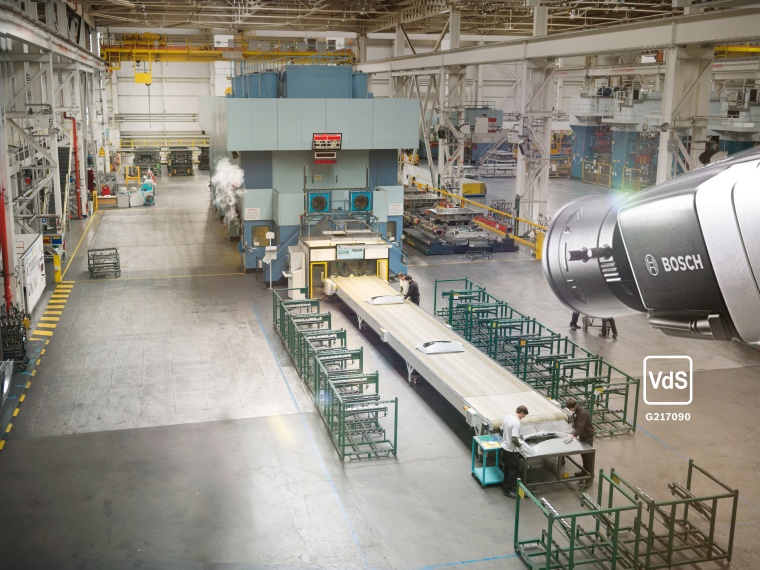Standards for Video-based Fire Detection
The limitations of conventional smoke and flame detection technologies quickly become apparent in demanding and harsh environments. In such cases, video-based technologies can be u...

The limitations of conventional smoke and flame detection technologies quickly become apparent in demanding and harsh environments. In such cases, video-based technologies can be used to guarantee safe and prompt detection with a minimal false alarm rate. Now, there is a new ISO specification on Video Fire Detectors.
As a general rule, smoke detection is regarded as a reliable option for prompt detection of fire, since smoke is usually generated before flames can be seen. However, conventional smoke detectors, such as point detectors and linear smoke detectors, but also other special detection technologies, are not designed to trigger an alarm until this smoke reaches them, which presents a challenge in large buildings with high ceilings, such as warehouses, terminals, hangers or generator halls. It can also be problematic to detect smoke in harsh environments with a number of disturbance variables, where it is often difficult to obtain the appropriate balance between sensitivity and immunity to false alarms.
Video-based fire detection detects smoke and flames without delay
Bosch’s video-based Aviotec IP starlight 8000 technology now offers a solution for demanding and harsh environments of this nature, which avoids many of the problems associated with conventional fire detection systems and makes it possible to detect flames and smoke promptly, even in unfavourable conditions, while virtually excluding false alarms. Furthermore, video-based fire detection is frequently the best option available in environments for which there has not been any solution whatsoever available to date. In some circumstances, this technology can even offer the potential to obtain insurance cover for environments that were previously uninsurable, such as sawmills.
The video-based flame and smoke detection system is based upon algorithms in an intelligent camera, which are able to use the physical characteristics of smoke and flames to identify a fire right at its source. This not only makes Aviotec prompt, it also means that it is virtually immune to false alarms. Intelligent video analysis within the sensor makes it possible to detect disturbance values such as movement, reflections or changes in lighting conditions, and to take steps to compensate for them.
Bosch’s core competences include video surveillance technology and the development of intelligent algorithms for visual analysis, as well as for fire detection. This means that fire-specific characteristics can be precisely detected and clearly distinguished from possible sources of interference. This expertise has led to the development of specific algorithms, permitting reliable fire detection within a matter of seconds. Examples of proven flame indicators are the orange-yellow colour spectrum as well as its characteristic flickering, and for smoke its typical movement, shape and dispersion. Algorithms as a basis particularly offer the option for continuous improvement and constantly increasing precision. On the other hand, the limitations of comparable technologies, which are based upon feeding in images for visual assessment, soon become apparent.
The Benefits of Video Fire Detection
One of the major benefits of video-based fire detection is its speed. Since video-based fire detectors can detect a fire as soon as the smoke enters their field of vision, and thus do not require the smoke to migrate to the sensor, they can be significantly faster than point, linear or aspiration smoke detectors.
In order to detect smoke quickly and efficiently, Aviotec algorithms use a physical smoke model to recognize smoke rising directly from the source. This model is based upon the shape assumed by smoke as it rises and dilutes as well as its characteristic movement pattern, among other information. The algorithms are able to make a reliable distinction between smoke and moving objects. They detect smoke obscuration levels as low as 30 percent, whereas most video-based solutions require levels of 50-65 percent. Since Aviotec is dependent upon the movement of smoke, the incipient fire must be within the camera’s field of vision. The solution is not designed to detect environmental smoke, since there are conventional technologies available to provide reliable and prompt detection in those cases.
As Reliable as Smoke Detection
Just as smoke detection is used in a physical smoke model, flame detection uses a physical flame model, based upon factors such as flame colour, flicker and shape. The flame characteristics of various fires have been comprehensively analysed, which means that the flame detection provided by intelligent video analysis is just as reliable as the smoke detection.
Using video to detect flames and smoke is not just prompt and safe; it also enables a full visualisation of the scene in real time, providing the operator with valuable time to fight the fire.
Another of the major benefits of Aviotec is that the algorithms used to detect smoke and flames are fully integrated into the camera, eliminating the need for any further analysis equipment. Once it has been installed, Aviotec IP starlight 8000 can also be used for automated surveillance tasks. The solution identifies unusual movements as well as blocked passageways or emergency exits and thus improves a site’s security, safety and cost-effectiveness. In warehouses, Aviotec can also help to prevent theft and arson; the latter being the second most common cause of fires in warehouses.
Aviotec can be scaled up from an individual detector to a networked system with a central management system. The solution can transmit alarms to a central fire detection panel or system, a monitoring centre or even to a mobile device by means of Ethernet. The ability to view video images in HD quality in real time on the way to a fire can help emergency services personnel to obtain a good understanding of the situation even before they reach the site.
At present, technical personnel must still verify alarms from Aviotec before an external alarm is transmitted to emergency services. This is standard practice for the industry, primarily to prevent false alarms in complex environments. The live camera image provides a very straightforward method to carry out verification. Direct external alarms from video-based fire detection can only be realised on the basis of corresponding standards.
Video and Certification
The new ISO/TS 7240-29:2017 is the first international specification for video fire detection. According to ISO it includes specified requirements, test methods and performance criteria for video fire detectors that operate in the visible spectrum. ISO has published this technical specification, but it is not binding and many experts consider it to be incomplete. North America has progressed one stage further: there, video-based fire detection can be certified in accordance with FM3232 and UL268B. EN 54 still does not include any standardsgoverning video-based fire detection, also because they usually follow ISO specifications. The VdS (German Insurance Association), the harmonized body for EN-54 certifications, has developed a demanding test procedure for Aviotec starlight 8000, incorporating the established VdS 2203 guidelines, “Requirements of fire protection software” and the “Specifications for the testing of flame detectors”, and it has been certified under the reference G217090. This serves to underline the quality of the product, since it has complied with the VdS’s stringent testing requirements for safe and speedy detection of test fires. Aviotec IP starlight 8000 is therefore the first system worldwide to hold a VdS certification as an “automatic video camera for visual monitoring of fires, which is used for the purpose of visually verifying fire events”. The VdS quality mark is a significant investment criterion for most safety experts in Europe. This is because the VdS’s comprehensive testing regime provides clear evidence of the reliability of fire protection systems designed to save lives in the worst-case scenario.
“As usual, our comprehensive tests not only cover the effectiveness and reliability of the Aviotec IP starlight 8000 product, but they also check long-term functional reliability, confirmed among other things by a function test following sulphur dioxide corrosion,” explains Philipp Mondrik, laboratory engineer at VdS’s fire detection system laboratories and project manager for the Aviotec tests. “In addition, functional reliability was tested under severe environmental conditions, such as increased heat, cold, moisture or the mechanical impacts typically occurring under operational conditions. Like our colleagues from intrusion, we have placed a particular emphasis upon avoiding false alarms.”
“Generally, our tests have demonstrated, that video-based fire detection can even enable “earliest possible detection” under ideal conditions. According to Mondrik, “the Aviotec IP starlight 8000 detected genuine incipient fires long before conventional optical smoke detectors installed on the ceiling, since smoke does not have to reach the detectors first; instead, it is visually detected right at the source of the fire.”














